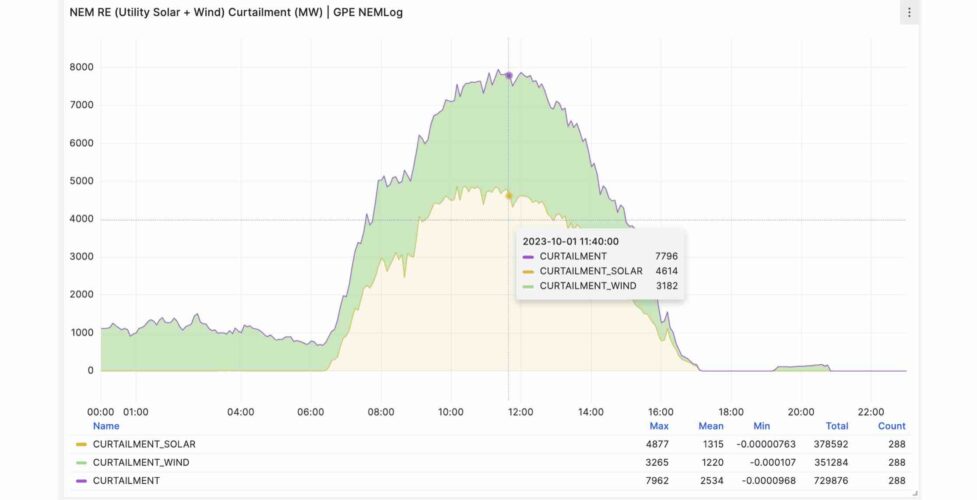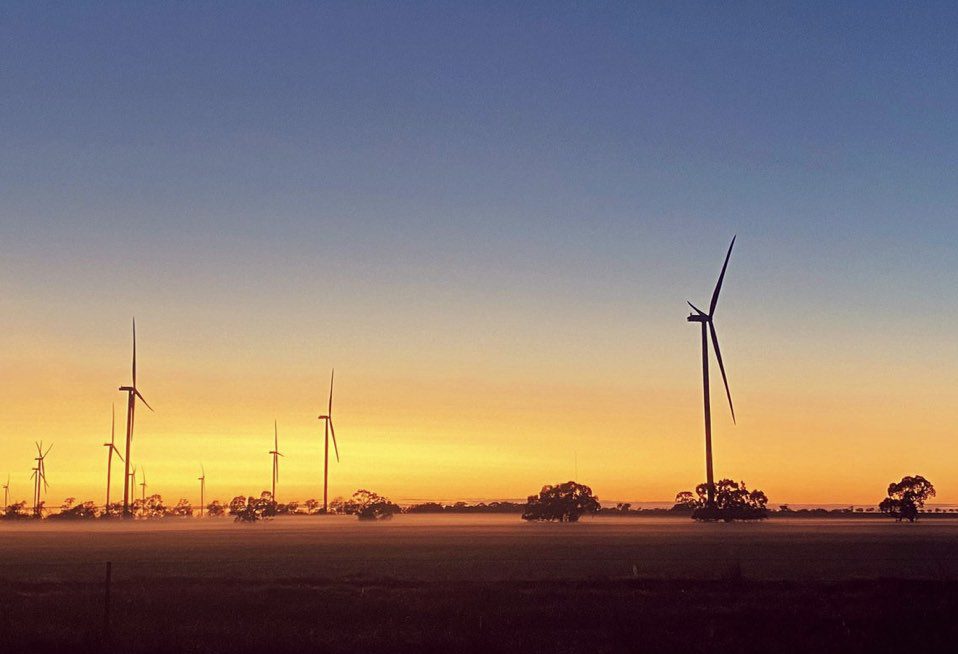Australia’s installed renewable energy capacity could have generated more than enough electricity to power the entire main grid for a brief time over the long weekend – but a variety of factors including negative pricing events and the presence of inflexible coal fired generators got in the way.
As noted on this and other websites, the National Electricity Market experienced a number of new records over the long weekend, most notably record low levels of coal output and new lows for grid demand, largely the result of the growing incursions of rooftop solar which accounted for more than half all generation at various times.
One significant data-point that was not highlighted was the level of actual renewable generation, plus the high level of curtailment of large scale wind and solar – 7796 MW at 1140 am (AEST) on Sunday.
If this curtailed output been allowed to flow, renewables would have delivered enough output to provide 101.4 per cent of grid demand at the time, according to data providers GPE NEMLog2.

That is a record for renewables production plus curtailment – up from the 100 per cent of demand first reached on September 16 this year, which was a big leap from the 90 per cent recorded last November.
Five years ago, the maximum level of renewable production plus curtailment was just 26 per cent, although in those days very little needed to be curtailed.
This new milestone appears to have been reached well ahead of the expectations of the Australian Energy Market Operator. When it released its engineering roadmap for 100 per cent renewables in July, it noted that the highest potential for renewables until then had been just below 90 per cent.
It said at the time that it expected that instances of 100 per cent renewables could be presented as early as 2025 – although it said it was not yet clear if it would be in a position to allow that to happen. It now turns that these instants are already occurring.
There are a bunch of reasons why the wind (3,182 MW) and large scale solar (4614 MW) was curtailed. Mostly it was because of negative prices, and contracts which require some of those facilities to switch off when prices go below zero.

Also, AEMO has made it clear isn’t yet ready to accommodate periods of 100 per cent renewables, because it still has that long list of engineering and operating protocols – identified in the July roadmap – that it needs to put in place to allow this to happen.
There are four key areas of focus – managing and “orchestrating” distributed energy such as rooftop solar, enabling new technology such as grid inverters, doing more power system studies, and building “operational readiness.”
When it does happen, it is sure to be a landmark moment, and a foretaste of the renewable grid – be it at 97 per cent, 98 per cent, 99 per cent or 100 per cent – that many analysts are predicting for Australia by the mid 2030s when the last of the big coal generators could close.
Some Australian state grids already operate at 100 per cent renewable or more on occasions, taking advantage of existing transmission links to export surplus renewables at times, at importing shortfalls at others.
Tasmania, for instance, does this on an almost daily basis thanks to its hydro resources, and South Australia also does this regularly, and has averaged more than 70 per cent renewables over the past 12 months, which is unique in the world for a grid its size because it all comes from wind and solar.
Over the last two weekends, rooftop solar alone has accounted for all of South Australia’s domestic demand at some points.
It can do this because it has connections to another grid to export surplus power, has four synchronous condensers working to provide system strength in the background, with the help of a couple of gas generators, and a growing fleet of big batteries to help manage any disruptions.
Victoria appears to be the next state to head towards times of 100 per cent renewables, largely from wind and solar, and it has a formal target of a 95 per cent renewables (year long average) by 2035, when it will have closed the last of its coal fired generators.
Analysts noted that Victoria reached a record 85.05 per cent share of variable renewable energy (wind and solar) on Sunday morning, and had enough capacity to reach 100 per cent were it not for the heavy curtailment – particularly of wind, in that state at the time.
Energy expert Tim Forcey noted that he was driving in regional Victoria at the time and noticed a lot of wind farms not turning, and he laid the blame for that on the inflexibility of the state’s brown coal generators, which do not like being ramped up and down.
Western Australia faces different challenges because it has no connections to other states, yet it is still able to accomodate up to 84 per cent wind and solar (its record to date), and up to 76 per cent rooftop solar alone – and is likely to increase these levels as it reforms its market and adds more storage.
See also David Leitch’s analysis: Spring shows how more wind and solar leads to low prices – once built
And: Rooftop solar smashes more records, sending coal output and grid demand to new lows











